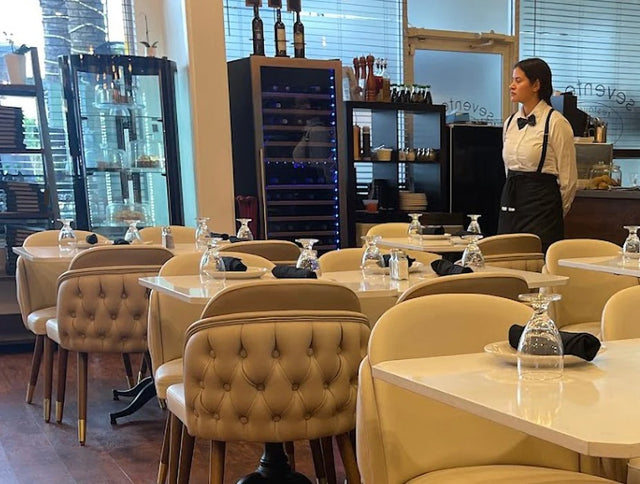Enhancing Restaurant Service Efficiency: Streamlined Operations with Furniture Solutions
In the fast-paced world of restaurants, service efficiency is paramount to success. The ability to deliver high-quality service quickly and seamlessly can make or break a dining experience for customers. This article will explore the importance of efficient restaurant service and how furniture solutions can play a significant role in streamlining operations.
Understanding the Importance of Efficient Restaurant Service
Efficient service is not just about saving time; it directly impacts customer satisfaction. When diners feel that their needs are met promptly, they leave with a positive impression of the restaurant and are more likely to return. On the other hand, slow and inefficient service can lead to frustration and disappointment, ultimately driving customers away.
Efficiency in restaurant service goes beyond just speed; it encompasses the entire customer experience from the moment they walk in until they leave. From greeting customers promptly to ensuring accurate orders and timely delivery of food, each step contributes to the overall efficiency of the service. This attention to detail creates a seamless dining experience that keeps customers coming back for more.
The Role of Service Efficiency in Customer Satisfaction
Efficient service ensures that customers' orders are taken promptly, food is served in a timely manner, and their overall dining experience is smooth. When customers receive efficient service, they feel valued and cared for, enhancing their satisfaction levels. This positive experience encourages them to recommend the restaurant to others and become loyal patrons themselves.
Moreover, efficient service can also lead to positive online reviews and word-of-mouth recommendations, further boosting the restaurant's reputation and attracting new customers. In today's digital age, where online reviews can make or break a business, the importance of efficient service in shaping customer perceptions cannot be overstated.
How Efficiency Impacts Restaurant Profitability
Efficiency is not only essential for customer satisfaction but also for the profitability of a restaurant. By optimizing service efficiency, restaurants can serve more customers in a shorter amount of time, increasing their revenue potential. Additionally, efficient operations help reduce waste, minimize labor costs, and improve overall profitability.
Furthermore, efficient service can lead to higher table turnover rates, allowing restaurants to accommodate more guests throughout the day. This increased capacity utilization directly translates to higher sales and profitability. By focusing on service efficiency, restaurants can create a win-win situation where customers are satisfied with their experience, and the business thrives financially.
The Connection Between Furniture and Restaurant Operations
The choice of furniture and its layout significantly impacts the efficiency of restaurant operations. When furniture is strategically placed and designed, it can facilitate smooth workflow and promote faster service.
Moreover, the aesthetic appeal of the furniture plays a crucial role in creating the desired ambiance for the restaurant. The style, color, and material of the furniture contribute to the overall theme and atmosphere of the dining space, influencing customers' perception of the establishment. For instance, modern and sleek furniture may attract a younger crowd seeking a trendy dining experience, while classic wooden furniture can evoke a sense of tradition and warmth.
The Influence of Furniture Layout on Workflow
The layout of furniture in a restaurant has a direct impact on the flow of operations. By arranging furniture in a way that maximizes space and minimizes obstructions, servers can navigate the dining area more efficiently. This allows them to serve customers quickly, reducing wait times, and increasing overall service efficiency.
In addition, the strategic placement of furniture can also influence customer behavior. Cozy seating arrangements encourage longer stays and promote a relaxed dining experience, ideal for establishments aiming to create a leisurely atmosphere. On the other hand, spaced-out seating with minimal barriers between tables can cater to customers looking for a quick meal, enhancing table turnover rates.
Furniture Choices and Their Impact on Service Speed
The type of furniture chosen for a restaurant can also affect service speed. For example, selecting comfortable yet lightweight chairs allows customers to move in and out of their seating area easily. Stackable chairs or tables with wheels can be quickly rearranged to accommodate larger groups or create more space during peak hours. These simple furniture choices can contribute to faster service and enhanced efficiency.
Furthermore, the durability and maintenance of the furniture are essential considerations for restaurant owners. Investing in high-quality, easy-to-clean furniture can save time and money in the long run, as it reduces the need for frequent repairs or replacements. By selecting furniture that is both functional and durable, restaurant operators can ensure a seamless dining experience for both customers and staff.
Strategies for Streamlining Operations with Furniture Solutions
Implementing the right furniture solutions can help restaurants streamline their operations and improve service efficiency. Consider the following strategies to make the most of your furniture:
Efficient furniture solutions are essential for restaurants looking to enhance their operational efficiency and customer experience. By carefully selecting and placing furniture, restaurant owners can create a space that not only looks inviting but also functions seamlessly to support the staff and customers.
Selecting the Right Furniture for Your Restaurant
When choosing furniture for your restaurant, prioritize functionality and durability. Look for furniture pieces that are easy to clean, resistant to wear and tear, and can withstand the demands of a busy dining establishment. Additionally, consider the aesthetic appeal of the furniture to ensure it aligns with your restaurant's theme and ambiance.
Investing in high-quality furniture may require a larger upfront cost, but it can lead to long-term savings by reducing the need for frequent replacements. Consider materials that are not only durable but also comfortable for guests, enhancing their overall dining experience and encouraging repeat visits.
Optimizing Furniture Placement for Improved Workflow
Carefully plan the layout of furniture to optimize workflow within your restaurant. Create clear pathways for servers to move freely between tables and the kitchen. Position furniture in a way that maximizes available space without overcrowding, allowing efficient movement of staff and customers. Regularly assess and adjust your furniture placement as needed to adapt to changing needs.
Strategic furniture placement can also contribute to the ambiance of the restaurant. By creating distinct seating areas or cozy corners, you can cater to different preferences of your customers, whether they seek privacy for intimate conversations or a lively atmosphere for group gatherings. Consider the flow of natural light and ventilation when arranging furniture to enhance the comfort of both guests and staff.
Overcoming Challenges in Implementing Furniture Solutions
While furniture solutions can significantly enhance service efficiency, there can be challenges in implementing them effectively. It is important to be mindful of potential obstacles and find ways to overcome them.
Implementing furniture solutions involves a careful balance of functionality, aesthetics, and practicality. Beyond just selecting and placing furniture, it is crucial to consider factors such as ergonomics, sustainability, and future scalability. By taking a holistic approach to furniture implementation, businesses can create spaces that not only look good but also promote productivity and well-being.
Addressing Common Obstacles in Furniture Selection and Placement
When selecting furniture, consider potential challenges such as limited space, budget constraints, and compatibility with existing decor. Find creative solutions that address these obstacles, such as multifunctional furniture pieces or exploring alternative layout options.
Moreover, conducting a thorough analysis of traffic flow, natural light sources, and acoustics can further enhance the effectiveness of furniture solutions. By optimizing the placement of furniture based on these factors, businesses can create spaces that are not only visually appealing but also conducive to collaboration and focus.
Ensuring Smooth Transition to New Furniture Arrangements
Introducing new furniture arrangements may require coordination and communication with staff. Proper training and clear communication about the benefits of the changes can help employees adapt smoothly to the new layout. Additionally, gather feedback from staff regularly to address any concerns and make adjustments as necessary.
Furthermore, incorporating elements of biophilic design, such as integrating natural elements and materials, can help create a sense of connection to the environment and improve overall well-being. By considering the psychological impact of furniture choices, businesses can create spaces that not only meet functional needs but also nurture a sense of comfort and inspiration among users.
Measuring the Impact of Furniture Solutions on Service Efficiency
Continuous assessment is crucial to determine the effectiveness of furniture solutions in enhancing service efficiency.
When evaluating the impact of furniture solutions on service efficiency, it is essential to consider not only the immediate effects but also the long-term benefits that can result from strategic choices. The layout and design of furniture in a restaurant can influence customer perceptions, staff productivity, and overall operational flow.
Key Indicators of Improved Service Efficiency
Monitor key performance indicators such as average table turnover time, customer feedback on service speed, and staff satisfaction levels. Regularly review and compare these indicators to assess the impact of furniture solutions.
Another important indicator to consider is the ergonomic design of furniture pieces. Comfortable seating arrangements can contribute to a positive dining experience, leading to increased customer satisfaction and potentially higher turnover rates.
Evaluating the Long-Term Benefits of Furniture Solutions
In addition to short-term improvements, consider the long-term benefits of furniture solutions. Increased customer satisfaction can lead to repeat business and positive word-of-mouth. Improved service efficiency can also contribute to higher employee morale and productivity. In the long run, these benefits can positively impact the overall success and profitability of a restaurant.
Furthermore, the aesthetic appeal of furniture choices can enhance the ambiance of a dining establishment, attracting new customers and creating a memorable dining experience. Investing in high-quality, visually appealing furniture can set a restaurant apart from its competitors and establish a strong brand identity.
In conclusion, enhancing restaurant service efficiency is crucial for customer satisfaction and financial success. Strategic furniture solutions can play a significant role in streamlining operations and improving service speed. By understanding the importance of efficient service, considering the impact of furniture choices, implementing smart strategies, and overcoming obstacles, restaurants can achieve enhanced service efficiency and create an outstanding dining experience for their customers.

